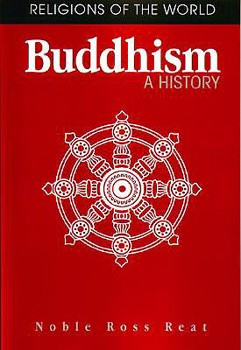Buddhism: A History
N. Ross Reat seems to have accomplished the impossible: a one-volume survey of Buddhism that is accurate, inclusive and readable. In an excellent narrative that links facts and ideas over three... This description may be from another edition of this product.
Format:Paperback
Language:English
ISBN:0875730027
ISBN13:9780875730028
Release Date:December 1994
Publisher:Jain Publishing Company
Length:376 Pages
Weight:1.15 lbs.
Dimensions:1.1" x 6.3" x 9.0"
Customer Reviews
5 ratings
Reasonably comprehensive and objective - a great beginning
Published by Thriftbooks.com User , 16 years ago
The thing about this book is that the author obviously really tries to be objective. His approach is conspicuously scholarly - he doesn't appear to have an agenda of any kind, other than to educate his audience about the history of Buddhism. He is respectful when dealing with both the Theravada and Mahayana schools of Buddhism, and although one detects his probable personal admiration for the Theravada and Vajrayana schools in particular, he tries to be as objective as one person can possibly be about all of the traditions. Some Buddhists may find his scholarly, rationalistic and intellectual approach to Buddhist history a bit offensive at times, but as he obviously trying to explore Buddhist history as truthfully as possible, I think he should be forgiven for any expressions of scepticism (which are not overwhelming - he is obviously a Buddhist sympathiser, if not a Buddhist himself). It was interesting to learn about Asian history, I felt he covered it well, although I would have liked more about Buddhism in central Asia - I guess he covered this in his interesting chapter about "Indian Buddhism".
Thorough history with overwhelming details
Published by Thriftbooks.com User , 18 years ago
This history of Buddhism traces the religion from its origins to the present day. The first few chapters of the book deal extensively with describing the early history of the religion in India and the philosophies and beliefs of Buddhism itself as well as the two primary divisions of Buddhism, Mahayana and Theraveda Buddhism. The rest of the book discusses at length the histories of Buddhist religion within individual countries and regions, with an emphasis on the various sects that originated within each country as well as their distinguishing characteristics. The end result provides the readers with a distinct view of how Buddhism has spread and evolved throughout Asia. The book ends with a discussion of Buddhism's spread outside of Asia that is disappointingly short. The book is quite thorough in its discussion of Buddhism, and it also includes general historical information on some regions of East Asia (such as Korea, Sri Lanka, Indochina, and Tibet) that are not discussed in most conventional Western world histories. In this light, the book is very good reading for people who want to thoroughly understand the overall history of East Asia rather than only the histories of the predominant countries in the region. Unfortunately, this book is overloaded with details on Buddhism. Too much information on what appear to be historically inconsequential Buddhist sects and minor Buddhist historical figures is presented in the book. In some sections, the history becomes the relentless mentioning of facts rather than the clear statement of significant events and their historical consequences. The various Asian names and terminology, which are difficult for anyone from any culture to keep track of, add to this problem. In effect, the fundamental lessons to be learned about Buddhist history sometimes become muddled by too many details. I ultimately recommend buying this book just to better understand Buddhism and East Asian history. The book's thorough discussion of Buddhism gives the readers everything they need to know for a basic understanding of the religion's history. However, this book relies too much on detail and too little on making clear, strong statements on the fundamental driving forces behind Buddhist history, which may be dissatisfying to some readers.
A fantastic source on Buddhism
Published by Thriftbooks.com User , 21 years ago
The development of the various schools and sects is treated in great detail. The philosophical bases of the different versions of Buddhism are compared and contrasted. It's also a good introduction to Asian history in general. Each country or region has its own chapter. I thought the emphasis given to the politicization of Buddhism and its importance in the emergence of the national identity of the various Asian peoples was especially good. I also learned how Buddhism greatly enriched Taoism, Confucianism, and Hinduism.
Essential reading for beginners
Published by Thriftbooks.com User , 23 years ago
Noble Ross Reat's 'Buddhism: A History' sheds new light on old theories of connections between Mahayana and Hinduism, the emergence of Mahayana philosophy as a reaction to Nikaya Buddhist philosophies, the importance of Nikaya Buddhism as the fundament of later (Mahayana) development, and the large cultural framework wherein Buddhism evolved to its present from. The emphasis and relativation of Mahayana in historical and philosophical context makes its importance brittle. He has a clear style, good argumentation, terrific insight and a no-nonsense approach. The rich text, unfortunately, is so inviting that one would wish for a larger elaboration and more Pali or Sanksrit terminology. Essential reading for advanced afficionados.
Terrific history of Buddhism
Published by Thriftbooks.com User , 25 years ago
My kind of book--Scholarly, humane, beautifully written, all-encompassing, precise, concise. Starting from the life of the Buddha, and describing the development of Buddhist thought as it spread from country to country, and describing Buddhism's part in Asian history, I was amazed by its completeness and intelligence.





